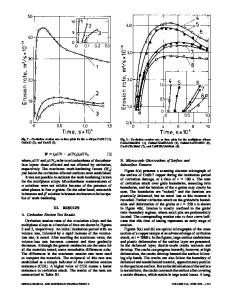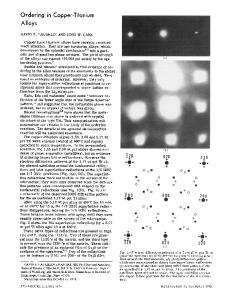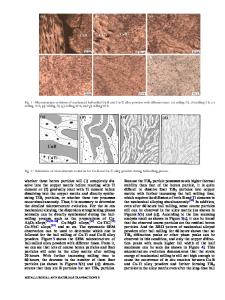Solid particle erosion mechanisms in copper and two copper alloys
- PDF / 6,884,214 Bytes
- 14 Pages / 594 x 774 pts Page_size
- 42 Downloads / 345 Views
IT
is generally agreed that the erosive removal of ductile metals by hard, high velocity ( - 50 to 400 m/s) particles occurs predominantly by the extrusion and loss of a lip more than any cutting action of the type found in machining. 1-3 However, the mechanism of the fracture of this lip is unclear. In carbon steelE and high strength (7075-T6) aluminum 4 weight loss occurs when, at a critical velocity, the front portion of the crater and extruded lip tears away from the material beneath. In Christman's study of 7075 aluminum the fracture surface had solidified metal droplets on the surface, suggesting that adiabatic shear localization and local melting played a central role in determining the fracture surface morphology. The weight loss per gm of erosive material, w, for a given alloy is independent of the heat treated hardness over a wide range of hardness in steel: and indeed to first order is independent of the structural material for common alloys of steel, nickel, aluminum and titaniumY There is no consensus on why the loss, w, is independent of the strength of the alloy, though it fits in with Hutchings postulate, for pure metals, that loss is proportional to the energy to heat the target metal to its melting point. 7 The theories put forward for metal loss under oblique impact assume that some fraction (1112 to 1/4) of the crater volume forms a lip that is lOSt.L2,5 In Finnie's original analysis the depth of the indent was taken to be proportional to the room temperature hardness of the target metal: This is certainly valid if the indent is made slowly. However, in the region quite close to the high speed particle the sudden deformation leads to intense local heating, and it is the flow properties in this hot, close-in material which determines the geometry of the lip and thus the weight loss. Striking examples of this local heating and extrusion have been seen on lime-silica glass impacted at TARIQ QUADIR, formerly a Graduate Student in the Department of Metallurgical Engineering, is now a Graduate Student in The Department of Ceramic Engineering at Ohio State University, Columbus, OH 43210. PAUL SHEWMON is a Professor and Chairman in the Metallurgical Engineering Department, OSU, Columbus, OH 43210. Manuscript submitted July 9, 1980.
room temperature, 9 but numerous other examples exist for ceramics9,1~and metals. 4,5 For normal incidence of the particles most theories require multiple impacts, cold work, and fatigue cracking. H,IE Christman, studying 7075 aluminum, found that while a single impact at 180 m/s gave no weight loss, a second normal impact partially overlapping the first gave a substantial loss when the wall of the second indent collapsed into the first.~3 Though the chip did not melt its fracture surface did before it separated. It was suggested that the molten layer formed by adiabatic shear localization in the wall, with the chip being torn loose by the inertial stresses setup across the shear plane when the specimen surface rebounded) 4 Similar experiments on commercially pure aluminum
Data Loading...











